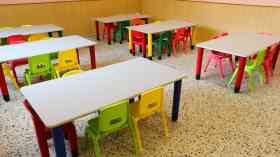
Indoor air pollution: why is it a problem?
A lack of regulation aimed at limiting indoor air pollutants is a serious problem. The Building Engineering Services Association explains why
The poor state of indoor air quality (IAQ) in thousands of homes is another powerful argument for a national programme of building retrofits, according to the Building Engineering Services Association (BESA).
The number of children living in damp homes has almost doubled since the Covid-19 pandemic. The figure has risen from one in 14 households living in privately rented accommodation to one in seven in 2022-23, according to the English Housing Survey.
That is almost 1.5 million children living in homes that failed decency standards with serious implications for their health and wellbeing.
Two-year-old Awaab Ishak who died as a direct result of being exposed to mouldy conditions in his Rochdale flat has become the public face of this scandal and the new Labour government has pledged to extend the reach of ‘Awaab’s Law’.
The legislation, which will now apply to the private sector as well as social housing, requires landlords in England to carry out emergency repairs within 24 hours, fully investigate issues within two weeks, and begin repairs within a further seven days. Failing to meet the deadlines leaves landlords liable to legal action by tenants and having to pay compensation.
“The promise to extend the reach of Awaab’s Law is something we called for during the general election campaign. It goes to the heart of efforts to tackle a growing health crisis caused by appalling conditions in far too many homes,” said BESA’s chief executive officer David Frise.
“The prevention and eradication of mould and damp continues to be a source of great frustration for our industry,” he added. “We understand the problem, which often comes back to inadequate ventilation, but too often the investment is not forthcoming despite this being such a crucial health issue.”
While landlords now face intense pressure to address issues like mould and damp in their properties, the Association recognises that this can be a complex issue with a range of hard to pin down causes and effects.
It cites a recent report published by the Royal Society of Chemistry which called for long-term funding for research into the complexities of IAQ and urged policymakers to consider more options for improving air inside homes and public buildings.
Like BESA, the Society believes IAQ remains something of a scientific mystery compared with outdoor air pollution which has been studied extensively. Public awareness campaigns, like National Clean Air Day, are primarily focused on the impact of outdoor pollution from transport and industrial processes with the cocktail of contaminants that create harmful indoor conditions only superficially mentioned.
Lack of indoor air pollution regulation
The RSC report highlighted the lack of regulation aimed at limiting indoor air pollutants such as VOCs which are linked to respiratory problems and nervous system damage. One helpful suggestion was the need for a nationwide “inventory of indoor emissions” to support research and increased monitoring of pollution levels in buildings. It also called for better mechanisms “to enable collaboration between disciplines…and a need for scientists to engage with policymakers, stakeholders and the wider public”.
The building engineering community must be at the heart of that collaboration as it can deliver the solutions given the right regulatory framework and funding – turning the physics and chemistry of the problem into real, practical outcomes.
Ventilation has a critical role to play in addressing many of the sources of indoor pollution that exacerbate a range of respiratory and cardiovascular conditions. In fact, it was recently stated by a leading healthcare professional that better building and facilities management could save more lives than the global medical and social care sectors combined.
While doctors and nurses can treat the symptoms of conditions like asthma and poor lung function, their patients then return to their homes and workplaces where the conditions that cause or worsen the problems still exist – and the cycle continues.
Air quality remains the world’s biggest “silent killer”, responsible for more deaths than cancer, heart disease, and mental health combined (as discussed on the recent BESA ‘Behind the Built Environment’ podcast) but unless targets are made mandatory other financial priorities will prevail.
A solution that’s part of the problem
BESA members also regularly point out that there is a painful irony in the fact that one increasingly popular ventilation solution is part of the problem. Thousands of mechanical ventilation with heat recovery (MVHR) systems have been fitted into heavily insulated and sealed homes.
Many were never commissioned; they were simply wired up and connected to flexible ducting that has been crammed into the available space without any allowance for air flow. Few are being checked or maintained, and many have been switched off by users because they are noisy. In many cases, they are the only source of ventilation for these tightly sealed and heavily insulated homes and the health impacts are already being seen.
The technology itself is not the issue, it is how it is being deployed. The lack of care at installation and absence of long-term maintenance means that a perfectly good solution is undermined.
“There are no silver bullets to addressing IAQ – and no ‘magic box’ air cleaning solutions,” said Adam Taylor, chair of BESA’s Indoor Air Quality group. “Improving IAQ is a building engineering issue that calls for solutions that can be applied throughout entire buildings.
“Individual products do play a big part in this, of course, but they must be part of a joined-up, whole building solution based around fully designed, professionally installed and commissioned systems that are then maintained throughout their lifetime and supported by ongoing measuring and monitoring of airborne contaminants.
“Just as net zero cannot be delivered by single technologies, such as heat pumps, so air quality in buildings requires integrated solutions,” added Taylor, who is also CEO of ARM Environments.
BESA produced its Guide to Mould and Damp last year and this is now being used by social and private sector landlords as a starting place for developing strategies for dealing with a problem that threatens to overwhelm them, but there is a long way to go.
And while the new government has shown willingness to act by its pledge to enforce Awaab’s Law, it is also facing an even wider test of its resolve on air quality in the High Court.
Air pollution campaigning
Nine-year-old Ella Kissi-Debrah was the first person in the UK to have air pollution recognised as a factor in her death following her fatal asthma attack in 2013. Subsequently, her mother Rosamund has campaigned tirelessly both for justice for her daughter and longer-term protection for all children from the damage caused by poor air quality.
Ella’s estate is suing three government departments for compensation over Ella’s “illness and premature death” and the case is due to be heard by the High Court later this year. However, this case is not about money, but rather, as Rosamund explains, about “holding their feet to the fire” and establishing a “legal right for all children to be able to breathe clean air”.
She added that “not much has happened” since the coroner in Ella’s case published a prevention of future deaths report. Currently, the government is still only committed to reducing air pollution by 2040 which condemns another whole generation of children to an uncertain future.
“It’s high time we had a public health campaign about the impact of air pollution on health,” said Rosamund, adding that a promise to revive the proposed new Clean Air Act was omitted from the Labour party election manifesto despite promises to the contrary.
BESA has been working with Rosamund for some years now. She has become a familiar figure at industry events and a captivating speaker at the Association’s annual conference and awards. She has been hugely influential in raising awareness of the role of ventilation and air filtration in improving indoor environments for health & wellbeing reasons.
“Schools, hospitals, care homes, and social housing are all key areas desperate for IAQ improvements, but they are desperate for other upgrades too. So, legislation will be needed to move air quality from the discretionary investment box to the essential,” said Adam Taylor.
Latest News
19/12/2025 - 09:54
The Education Committee has expanded its ongoing inquiry into the early years sector to examine how safeguarding can be strengthened in early years settings.
18/12/2025 - 09:25
The UK will be rejoining the Erasmus programme in 2027, following a package of agreements with the EU.
17/12/2025 - 09:31
Ofqual has fined exam board Pearson more than £2 million in total for serious breaches in three separate cases between 2019 and 2023 which collectively affected tens of thousands of students.
16/12/2025 - 09:19
The average funding rates will increase by 4.3% for under 2s, and by almost 5% for 3-and-4-year-olds.
15/12/2025 - 10:30
Local colleges are set to receive £570 million in government funding to expand training facilities in areas such as construction and engineering.







